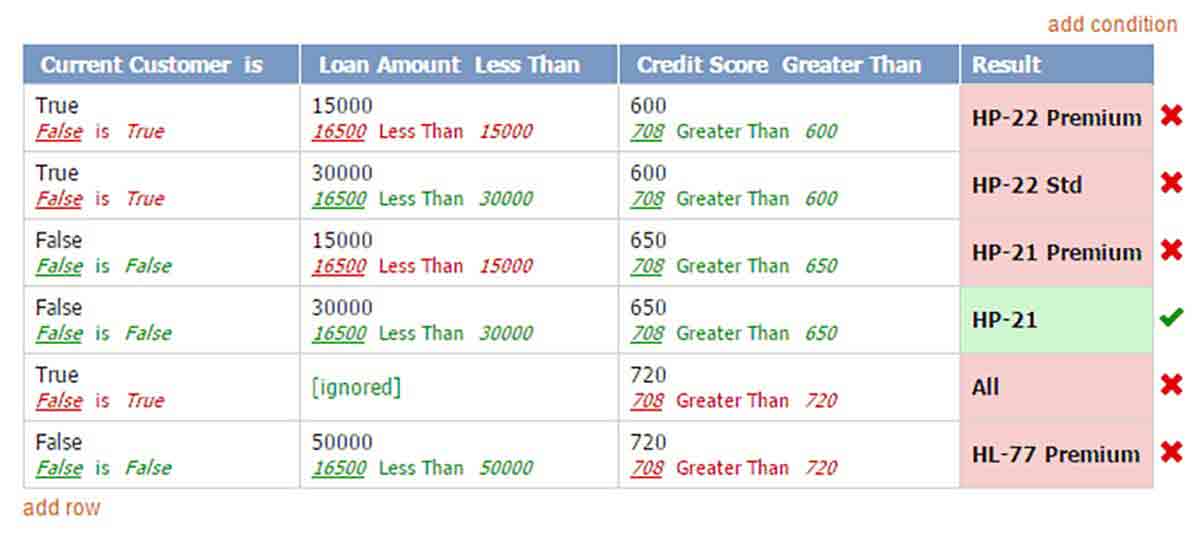Understanding External Truth Tables: Applications for Your Business

Truth tables are used to provide a visual organization of information when looking into all of the possible outcomes and scenarios from the provided premises. Though most common in mathematics, truth tables have also been used in computer science, electrical engineering, and even philosophy. Given the wide range of uses for truth tables, it should be no surprise to see them applied to business workflows and processes as well.
In the business world, a truth table is a rule represented as a table that compares the possible outcomes of different inputs in your business process automation solution and kicks off workflows based on the output.
Here’s a simple example: A customer inputs an order for 1,000 red mugs. A truth table would dissect the inputs mug, red, and 1,000 to see if there was enough of this particular item in stock. The workflow may then come from your truth table requiring orders of more than 1,000 pieces to have approval from someone in your organization or require a PO or partial payment. The workflow is then forwarded to the appropriate approver for further action.
Why Use an External Truth Table?
When using an external truth table, the rows or values come from a report outside of your business process automation software. This report can come from an Excel file, a .csv file, a database, or even a web service or message queue. Because this type of truth table is built outside of your business process automation solution, you cannot edit it in your business automation platform. In order to make any changes, you would have to edit the source of the input data and then bring it back in as a report.
So why would you use external data from a truth table that you did not build yourself when automating a business process? There are actually quite a few reasons why.
For starters, you may be working with a large set of rules. You may have a database with thousands of records that you need to work with. In this case, rebuilding this truth table on your own would be a tedious effort. You could save quite a bit of time by using an external truth table from the database report.
Another reason why you may want to rely on an external truth table is if you are working with data that is growing or changing in other ways. For example, if you are working with data from your customer relationship management (CRM) solution, you may wish to produce reports to use as truth tables. CRM solutions are consistently growing and changing based on customer outreach and campaigns. To build a new truth table from scratch would waste valuable time you could spend analyzing this data. Anytime you know the number of rules will change or grow, you will want to rely on data sourced from reports you consistently run to get the latest data.
Relying on external truth tables also gives you a single source of truth to work from. If you rebuild a truth table based on rules from a web service, you will have to edit that truth table each time there is a change. If you make a mistake when editing, you will have two different data sets. If you forget or don’t have a chance to update the truth table, you will have different data sets. If you run the report from your web services and bring this data into your business process automation software as an external truth table, then your data remains consistent and accurate.
Truth tables offer you the opportunity to represent rules in your business processes, define conditions, and display results in an easy-to-understand visual artifact. To see how easy it is to work with truth tables, take a few minutes to view these videos. For a more in-depth look at how to use truth tables with a focus on external truth tables, sign up to view this webinar. The webinar covers truth tables and their use, how to build truth tables, and how you can bring in external truth tables when needed.
Latest Articles
- Why Digital-First Loan Origination Is No Longer Optional
- Solving the Complexity Crisis in Excess & Surplus Insurance
- Fixing Lead Management with a Rules-Driven Approach: Why You Don’t Need Another Martech Tool
- Balancing Risk and Profitability: The Key to Smarter Insurance Pricing
- Blueprint Two Phase II: From Oversight to Bordereaux
- Rethinking Lead Flow Logic with Rules-Driven Automation: Why You Don’t Need Another Martech Tool
- Taming the Complexity of Workers’ Compensation Insurance—Before Inefficiencies Cost You More
- Improving Institutional Efficiency: How Process Mining Enhances University Operations
- Dynamic Pricing in Specialty Insurance: Adapting Rates in Real-Time
- The Faster, Smarter, No-Cost Chatbot Solution
- Extending SAP Capabilities with Low-Code Automation
- Why Your Automation Strategy Is Incomplete Without Process Mining
- 7 Fraud Prevention Tactics You Can Automate with a Rules Engine
- How Smart Lenders Use Low-Code Automation to Stay Fast, Compliant, and Competitive
- How Universities Can Protect Millions in Revenue with Faster Appeals

